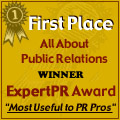|
Jill
Lublin
(Seven Steps to Publicity -
Continued)
Step # 3 is to define your
audience and create a media list.
Your list will, of course, be
determined by the nature of your
product or service, whether you
are a local, national or
international company and on which
markets you are focusing your
growth If you are a
"local" trying to build
a business in your community, then
you will focus on local media. 
On
the other hand, if you are
pursuing national growth, you will
want to check out major newspapers
such as the Wall Street Journal,
entrepreneurial publications such
as Fortune or Inc.,
or gender specific magazines such
as Good Housekeeping or Men's
Health. Another good source
might be the trade or sales
magazines for your profession or
specialty. (You can find other
leads under Media
Directories.) It's
important to familiarize yourself
with all the media you contact and
to make preliminary phone calls to
get the appropriate name for
directing your release or media
kit. Do an update at least every
three months. A local list could
easily have 100 names, and for
national media 400 names would not
be too many.
Step #4 is time to put
together a press release a simple
3-4-paragraph one-page document
that tells your story clearly. It
must be unique to grab media
attention FAST. The first
paragraph must contain the
"catch" phrase to grab
them quickly. It should contain
the who, what, when, where, why,
and how of your story and begin
with the city and state of
origination. (See the PR
Toolkit for media release
format samples.) Techniques for
grabbing attention include giving
a statistic showing that their
audience needs this information,
that it's relevant to current
events or business news. The
second paragraph might consist of
a quick biography or additional
information, and the third should
contain a quote from the highest
source you can find. It is always
better to use someone else's words
to praise you. Sometimes the media
will only use the first paragraph,
so it must contain all the
relevant information.
Step #5 will involve
creating a media kit which
includes a copy of your media
release as well as other
information. This is used to
create interest for the media to
do a full story or have you appear
on a TV or radio show. It is
important to understand that each
type of media has their own unique
requirements for their particular
audience. Obviously TV producers
are interested in a
"visual" hook, so you
should include clear easily
reproducible images. Radio will be
more interested in the news hook
or verbal aspect of your story.
Just as you worked on your short
term message at the beginning of
your PR campaign, now you need to
work on how best to exploit that
image. How will you tell your
story most effectively? It
needs to be personal so an
audience can put itself in your
shoes, identify with it, and apply
it to their own lives. It also
must be interesting and give value
and benefit to the audience.
Your
media kit should also include a
company background piece or
brochure, a pricing sheet, any
press clippings (reproduced on
your stationary), and any other
public relations materials.
Grabbing attention is imperative
so packaging is critical. This
involves the careful selection of
eye-catching colors for the folder
as well as the contents. Quality
says a lot so don't skimp.
Consider having the cover embossed
or using a logo sticker, select a
folder with a business card
insert, and select easy to read,
crisp clear text and quality
paper.
Next page > Bring
it on Home > Page 1,
2, 3
More
Articles | Submit
Your Article | PR
Subjects
About
Public Relations Homepage
Contact Us
Your $5 contribution helps keep us online
|



